CO
-
 KAIST, Hynix Agree to Cooperate in Fostering Skilled Manpower
KAIST and Hynix Semiconductor, the world’s second largest producer of dynamic random access memory (DRAM) chips, have agreed to promote bilateral cooperation in fostering highly skilled manpower for the semiconductor industry. A signing ceremony was held on Jan. 21 in Seoul.
The agreement marked an expansion of the scope of cooperation between the two organizations into the system IC industry. Since 1995, KAIST and Hynix have cooperated in fostering human resource specialized in the memory semiconductor area, bringing up a total of 250 highly skilled personnel in the area so far. Under the new agreement, Hynix will provide financial support, including scholarships, to KAIST for the next five years. The number of students subject to the Hynix-financed program will be increased to 20 a year from the current 10. New material engineering and physics will be added to the areas covered by the cooperation program.
2008.01.29 View 12043
KAIST, Hynix Agree to Cooperate in Fostering Skilled Manpower
KAIST and Hynix Semiconductor, the world’s second largest producer of dynamic random access memory (DRAM) chips, have agreed to promote bilateral cooperation in fostering highly skilled manpower for the semiconductor industry. A signing ceremony was held on Jan. 21 in Seoul.
The agreement marked an expansion of the scope of cooperation between the two organizations into the system IC industry. Since 1995, KAIST and Hynix have cooperated in fostering human resource specialized in the memory semiconductor area, bringing up a total of 250 highly skilled personnel in the area so far. Under the new agreement, Hynix will provide financial support, including scholarships, to KAIST for the next five years. The number of students subject to the Hynix-financed program will be increased to 20 a year from the current 10. New material engineering and physics will be added to the areas covered by the cooperation program.
2008.01.29 View 12043 -
 KAIST Introduces Dual Degree Program for MBA with American and British
Korea Advanced Institute of Science and Technology (KAIST) Graduate School of finance signed a dual degree program contract with the University of Rochester and London Business School. Starting from the entering class of 2009, the dual degree program will allow students of the Graduate School of finance to attend ten lectures in a foreign university and receive degrees from both institutes. After the dual degree program is applied, in the case of the University of Rochester, KAIST students will finish three terms at KAIST Graduate School of Business. Then the students will spend the last eight months in the University of Rochester. This opportunity will be given to roughly 20 students out of 100 entering students.KAIST MBA School was built in 1995 and has been operated as the Graduate School of Business Administration for ten years. Then, it was developed into two major departments: the Graduate School of finance and the Graduate School of information and media. After the division, they have chosen the dual degree program as the strategy for building up the capability of the Graduate School of Business.The dual degree program of KAIST has a unique feature that other MBA Schools do not have. Once a student is selected by KAIST to participate in the dual degree program, the student will be able to study in the foreign university even if he or she had been rejected from it. This is an important characteristic that differentiates KAIST from other MBA Schools where students need to have approvals from both universities.As well as the Graduate School of finance, the Graduate School of information and media is currently working on signing a dual degree program contract with Marshall University. Once a contract on Memorandum of Understanding is signed, students will be able to receive MBA degrees from both KAIST and Marshall University.The University of Rochester is a MBA School specializing in finance, which in 2007, was ranked 5th in financial affairs and accounting according to Financial Times. Currently, 14 KAIST students are enrolled in a dual degree program for MBA in the university.By KAIST Herald on November 2007
2007.12.21 View 14336
KAIST Introduces Dual Degree Program for MBA with American and British
Korea Advanced Institute of Science and Technology (KAIST) Graduate School of finance signed a dual degree program contract with the University of Rochester and London Business School. Starting from the entering class of 2009, the dual degree program will allow students of the Graduate School of finance to attend ten lectures in a foreign university and receive degrees from both institutes. After the dual degree program is applied, in the case of the University of Rochester, KAIST students will finish three terms at KAIST Graduate School of Business. Then the students will spend the last eight months in the University of Rochester. This opportunity will be given to roughly 20 students out of 100 entering students.KAIST MBA School was built in 1995 and has been operated as the Graduate School of Business Administration for ten years. Then, it was developed into two major departments: the Graduate School of finance and the Graduate School of information and media. After the division, they have chosen the dual degree program as the strategy for building up the capability of the Graduate School of Business.The dual degree program of KAIST has a unique feature that other MBA Schools do not have. Once a student is selected by KAIST to participate in the dual degree program, the student will be able to study in the foreign university even if he or she had been rejected from it. This is an important characteristic that differentiates KAIST from other MBA Schools where students need to have approvals from both universities.As well as the Graduate School of finance, the Graduate School of information and media is currently working on signing a dual degree program contract with Marshall University. Once a contract on Memorandum of Understanding is signed, students will be able to receive MBA degrees from both KAIST and Marshall University.The University of Rochester is a MBA School specializing in finance, which in 2007, was ranked 5th in financial affairs and accounting according to Financial Times. Currently, 14 KAIST students are enrolled in a dual degree program for MBA in the university.By KAIST Herald on November 2007
2007.12.21 View 14336 -
 Three Professors Selected as IEEE Fellows
Three Korea Advanced Institute of Science and Technology (KAIST)’s professors, Ju-Jang Lee, Yong-Hee Lee, and Hoi-Jun Yoo, were selected as a part of the 2008 Institute of Electrical and Electronics Engineers, Inc (IEEE)’s “Fellows.” A Fellow is the highest level of membership given only to those “with an extraordinary record of accomplishments” in their field of study. Although some IEEE memberships can be gained freely by all, the Fellow status is bestowed only by the IEEE Board of Directors.
Professor Ju-Jang Lee was awarded the Fellow status “for contributions to intelligent robust control and robotics.” Robust control is a system’s stable maintenance under many inputs in a dynamic environment. A part of KAIST’s Electrical Engineering Department, Professor Ju-Jang Lee has conducted successful research in these fields, and has published 538 papers. He also holds many patents in and outside of the country, and is the General Chair for two upcoming IEEE conferences in 2008 and 2009.
Professor Yong-Hee Lee of KAIST’s Physics Department was recognized for his “contributions to photonic devices based upon vertical cavity surface emitting lasers and photonic crystals.” Photonic devices are those that allow the practical use of photons, and photon crystals are structures that affect the motion of photons. Professor Yong-Hee Lee is an expert in the field of Photonics and his works have been cited over 2500 times. He is also an outstanding speaker, giving over 30 lectures in front of international audiences in the past 5 years, and receiving The Distinguished Lecturer’s Award from IEEE.
Professor Hoi-Jun Yoo was granted the prestigious Fellow status for his “contributions to low-power and high-speed VLSI design.” VLSI stands for ‘very large scale integration’ and refers to the skill for packing a huge number of semiconductors on an integrated circuit. Professor Lee’s Fellow status is noteworthy in that he studied, worked, and researched solely in Korea. He is also the youngest of the three KAIST professors to be granted membership in the class of 2008 Fellowship. IEEE also recognized Professor Yoo as the most frequent publisher during the past 8 years.
IEEE, originally concentrating on Electric Engineering, has now branched into many related fields. It is a nonprofit organization, and its aim is to be the world"s leading professional association for the advancement of technology. For its Fellow Class of 2008, 295 members were chosen; which is less that 0.1% of their total members.By KAIST Herald on December, 2007
2007.12.21 View 20514
Three Professors Selected as IEEE Fellows
Three Korea Advanced Institute of Science and Technology (KAIST)’s professors, Ju-Jang Lee, Yong-Hee Lee, and Hoi-Jun Yoo, were selected as a part of the 2008 Institute of Electrical and Electronics Engineers, Inc (IEEE)’s “Fellows.” A Fellow is the highest level of membership given only to those “with an extraordinary record of accomplishments” in their field of study. Although some IEEE memberships can be gained freely by all, the Fellow status is bestowed only by the IEEE Board of Directors.
Professor Ju-Jang Lee was awarded the Fellow status “for contributions to intelligent robust control and robotics.” Robust control is a system’s stable maintenance under many inputs in a dynamic environment. A part of KAIST’s Electrical Engineering Department, Professor Ju-Jang Lee has conducted successful research in these fields, and has published 538 papers. He also holds many patents in and outside of the country, and is the General Chair for two upcoming IEEE conferences in 2008 and 2009.
Professor Yong-Hee Lee of KAIST’s Physics Department was recognized for his “contributions to photonic devices based upon vertical cavity surface emitting lasers and photonic crystals.” Photonic devices are those that allow the practical use of photons, and photon crystals are structures that affect the motion of photons. Professor Yong-Hee Lee is an expert in the field of Photonics and his works have been cited over 2500 times. He is also an outstanding speaker, giving over 30 lectures in front of international audiences in the past 5 years, and receiving The Distinguished Lecturer’s Award from IEEE.
Professor Hoi-Jun Yoo was granted the prestigious Fellow status for his “contributions to low-power and high-speed VLSI design.” VLSI stands for ‘very large scale integration’ and refers to the skill for packing a huge number of semiconductors on an integrated circuit. Professor Lee’s Fellow status is noteworthy in that he studied, worked, and researched solely in Korea. He is also the youngest of the three KAIST professors to be granted membership in the class of 2008 Fellowship. IEEE also recognized Professor Yoo as the most frequent publisher during the past 8 years.
IEEE, originally concentrating on Electric Engineering, has now branched into many related fields. It is a nonprofit organization, and its aim is to be the world"s leading professional association for the advancement of technology. For its Fellow Class of 2008, 295 members were chosen; which is less that 0.1% of their total members.By KAIST Herald on December, 2007
2007.12.21 View 20514 -
 KAIST Takes Merging Steps with ICU
Plans to begin the merging of Korea Advanced Institute of Science and Technology (KAIST) and Information and Communications University (ICU) have emerged.
ICU board members and Ministry of Information and Communications (MIC) officials held a meeting at Lotte Hotel, Seoul, on November 21st. The two parties agreed upon the merging of KAIST and ICU; and an interim organization to carry out the merging procedures was to be established. In addition, a preliminary road-map was presented during the meeting.
In the event that a company would show a willingness to financially support ICU, the parties agreed to take this path into consideration as well.
Also at this meeting, the resignation of ICU President Huh Unna was accepted by the board members of ICU. President Huh and the executive board have opposed any proposals of unification between the two universities. The president called for an independent ICU in response to MIC’s withdrawal of funding.
On November 27th, ICU Electrical Engineering Professor Hyuck Jae Lee was appointed as ICU president.
The talk of merging the two universities surfaced when the Board of Audit and Inspection concluded that financial support of ICU from the government was illegal as ICU was established under the private school law exempting the institution from governmental support. When ICU was established in 1997, MIC provided 200 billion Korean Won and has continually supported the university financially with 10 billion Korean Won per year.
Both universities have not released official statements regarding the merging of the respective institutions.
ICU has a student body of about 400 undergraduate students and 600 graduate students. On the other hand, KAIST has a student body of around 3000 undergraduate students, 2000 graduate students, and 2000 doctorate students. Both institutions are located in Daejeon, Korea.
Talk of establishing a single-department IT-convergence university where ICU is currently located surfaced as a possible merging-concept by KAIST.
Organizations and groups opposing the unification of the two technology-related institutions are concerned with details of the merger, such as the personnel management of ICU professors. However, analyses demonstrate that the unification will give KAIST the competitive edge through a larger faculty, student body, and increased facilities.
In July, an in-house poll was conducted at ICU and the results showed that 15 percent of graduate school students and undergraduate students were against the merger while 82.6 percent of undergraduate students and 84.8 percent of graduate students were in favor. 88.6 percent of ICU professors supported the unification of the two universities.By KAIST Herald on December, 2007
2007.12.21 View 13916
KAIST Takes Merging Steps with ICU
Plans to begin the merging of Korea Advanced Institute of Science and Technology (KAIST) and Information and Communications University (ICU) have emerged.
ICU board members and Ministry of Information and Communications (MIC) officials held a meeting at Lotte Hotel, Seoul, on November 21st. The two parties agreed upon the merging of KAIST and ICU; and an interim organization to carry out the merging procedures was to be established. In addition, a preliminary road-map was presented during the meeting.
In the event that a company would show a willingness to financially support ICU, the parties agreed to take this path into consideration as well.
Also at this meeting, the resignation of ICU President Huh Unna was accepted by the board members of ICU. President Huh and the executive board have opposed any proposals of unification between the two universities. The president called for an independent ICU in response to MIC’s withdrawal of funding.
On November 27th, ICU Electrical Engineering Professor Hyuck Jae Lee was appointed as ICU president.
The talk of merging the two universities surfaced when the Board of Audit and Inspection concluded that financial support of ICU from the government was illegal as ICU was established under the private school law exempting the institution from governmental support. When ICU was established in 1997, MIC provided 200 billion Korean Won and has continually supported the university financially with 10 billion Korean Won per year.
Both universities have not released official statements regarding the merging of the respective institutions.
ICU has a student body of about 400 undergraduate students and 600 graduate students. On the other hand, KAIST has a student body of around 3000 undergraduate students, 2000 graduate students, and 2000 doctorate students. Both institutions are located in Daejeon, Korea.
Talk of establishing a single-department IT-convergence university where ICU is currently located surfaced as a possible merging-concept by KAIST.
Organizations and groups opposing the unification of the two technology-related institutions are concerned with details of the merger, such as the personnel management of ICU professors. However, analyses demonstrate that the unification will give KAIST the competitive edge through a larger faculty, student body, and increased facilities.
In July, an in-house poll was conducted at ICU and the results showed that 15 percent of graduate school students and undergraduate students were against the merger while 82.6 percent of undergraduate students and 84.8 percent of graduate students were in favor. 88.6 percent of ICU professors supported the unification of the two universities.By KAIST Herald on December, 2007
2007.12.21 View 13916 -
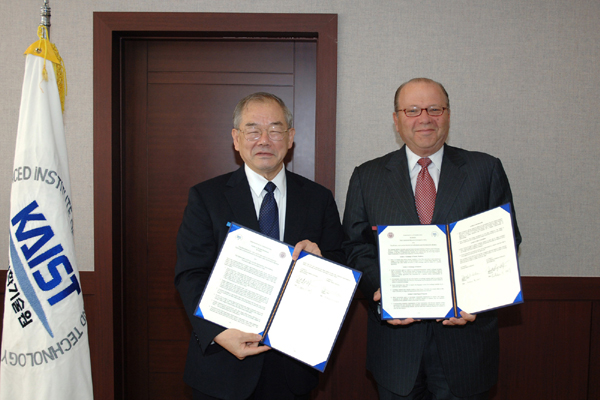 KAIST and Carnegie Mellon University establish a Dual Degree Program
Korea Advanced Institute of Science and Technology (KAIST) and Carnegie Mellon University make an agreement on collaboration in research and education, and a dual degree program.
KAIST and Carnegie Mellon make an agreement on ▲Exchange of Faculty Members ▲Exchange of Students ▲Dual Degree Program and ▲ Exploring cooperation in education and research. Presidents of both Universities had a signing ceremony at 11 A.M on Friday, Oct. 5th, 2007.
▲Lectures, joint research and exchange of faculty members ▲Undergraduate/graduate student exchange up to five students from one University each year ▲Dual degree program at the Ph. D. level ▲Opportunities for joint research projects and conferences will be explored according to the agreement between the two Universities.
KAIST and Carnegie Mellon have created a new dual degree program for Ph.D. students in civil and environmental engineering. Students admitted through the dual degree program are required to spend minimum 2 academic years in residence at each University. The total number of the student candidates participating in this program shall not exceed five in any given academic year initially. The students who met the graduation requirements shall be awarded two PhD degrees, one from KAIST and the other from Carnegie Mellon. All of its courses at KAIST are taught in English, which is the case starting in Fall 2007. Both Universities will explore the concept of sharing courses taught in English using videoconferencing technologies.
KAIST President Nam Pyo Suh said “We are delighted to have President Jared L. Cohon of Carnegie Mellon visit KAIST. I am looking forward to discussing various issues related to higher education and signing the Memorandum of Understanding between the two universities for student/faculty exchange programs, joint research, and the Carnegie Mellon- KAIST dual-degree program in civil and environment engineering. The dual degree program will initially begin in civil and environment engineering, and we hope to expand this to other areas in the future. Our goal is to generate future leaders who are able to lead global enterprises and conduct interdisciplinary research. This can be done through collaboration among leading scholars at Carnegie Mellon and KAIST. Our hope is that we can solve serious problems of the 21st century through the collaboration between our two institutions. I am especially excited to establish such a collaboration with Carnegie Mellon, my alma mater."
“Carnegie Mellon is well-suited to collaborate with KAIST. We believe this agreement will be a catalyst for future educational and research opportunities. I am especially pleased that this partnership is with an institution of KAIST"s stature” said Cohon.
About Carnegie Mellon:
Carnegie Mellon is a private research university with a distinctive mix of programs in engineering, computer science, robotics, business, public policy, fine arts and the humanities. More than 10,000 undergraduate and graduate students receive an education characterized by its focus on creating and implementing solutions for real problems, interdisciplinary collaboration, and innovation. A small student-to-faculty ratio provides an opportunity for close interaction between students and professors. While technology is pervasive on its 144-acre Pittsburgh campus, Carnegie Mellon is also distinctive among leading research universities for the world-renowned programs in its College of Fine Arts. A global university, Carnegie Mellon has campuses in Silicon Valley, Calif., and Qatar, and programs in Asia, Australia and Europe. For more, see www.cmu.edu ..
2007.10.09 View 19493
KAIST and Carnegie Mellon University establish a Dual Degree Program
Korea Advanced Institute of Science and Technology (KAIST) and Carnegie Mellon University make an agreement on collaboration in research and education, and a dual degree program.
KAIST and Carnegie Mellon make an agreement on ▲Exchange of Faculty Members ▲Exchange of Students ▲Dual Degree Program and ▲ Exploring cooperation in education and research. Presidents of both Universities had a signing ceremony at 11 A.M on Friday, Oct. 5th, 2007.
▲Lectures, joint research and exchange of faculty members ▲Undergraduate/graduate student exchange up to five students from one University each year ▲Dual degree program at the Ph. D. level ▲Opportunities for joint research projects and conferences will be explored according to the agreement between the two Universities.
KAIST and Carnegie Mellon have created a new dual degree program for Ph.D. students in civil and environmental engineering. Students admitted through the dual degree program are required to spend minimum 2 academic years in residence at each University. The total number of the student candidates participating in this program shall not exceed five in any given academic year initially. The students who met the graduation requirements shall be awarded two PhD degrees, one from KAIST and the other from Carnegie Mellon. All of its courses at KAIST are taught in English, which is the case starting in Fall 2007. Both Universities will explore the concept of sharing courses taught in English using videoconferencing technologies.
KAIST President Nam Pyo Suh said “We are delighted to have President Jared L. Cohon of Carnegie Mellon visit KAIST. I am looking forward to discussing various issues related to higher education and signing the Memorandum of Understanding between the two universities for student/faculty exchange programs, joint research, and the Carnegie Mellon- KAIST dual-degree program in civil and environment engineering. The dual degree program will initially begin in civil and environment engineering, and we hope to expand this to other areas in the future. Our goal is to generate future leaders who are able to lead global enterprises and conduct interdisciplinary research. This can be done through collaboration among leading scholars at Carnegie Mellon and KAIST. Our hope is that we can solve serious problems of the 21st century through the collaboration between our two institutions. I am especially excited to establish such a collaboration with Carnegie Mellon, my alma mater."
“Carnegie Mellon is well-suited to collaborate with KAIST. We believe this agreement will be a catalyst for future educational and research opportunities. I am especially pleased that this partnership is with an institution of KAIST"s stature” said Cohon.
About Carnegie Mellon:
Carnegie Mellon is a private research university with a distinctive mix of programs in engineering, computer science, robotics, business, public policy, fine arts and the humanities. More than 10,000 undergraduate and graduate students receive an education characterized by its focus on creating and implementing solutions for real problems, interdisciplinary collaboration, and innovation. A small student-to-faculty ratio provides an opportunity for close interaction between students and professors. While technology is pervasive on its 144-acre Pittsburgh campus, Carnegie Mellon is also distinctive among leading research universities for the world-renowned programs in its College of Fine Arts. A global university, Carnegie Mellon has campuses in Silicon Valley, Calif., and Qatar, and programs in Asia, Australia and Europe. For more, see www.cmu.edu ..
2007.10.09 View 19493 -
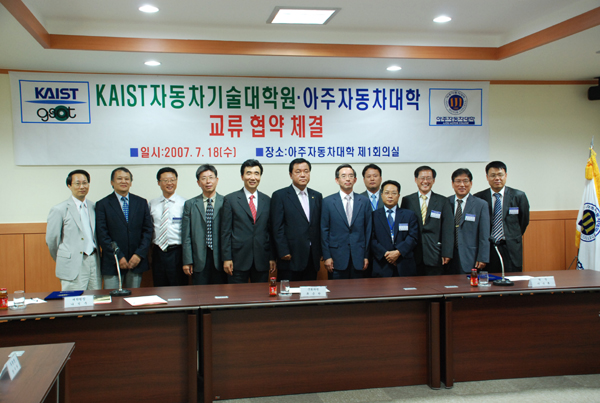 Cooperation Agreement with Ajou Motor College
Cooperation Agreement with Ajou Motor College
KAIST Graduate School of Automobile Technology to sign a cooperation agreement with Ajou Motor College
KAIST Graduate School of Automobile Technology (GSAT) signed a cooperation agreement with Ajou Motor College (AMC) on July 18th.
Under the agreement, the both schools will share education and research facilities and promote mutual cooperation for joint education and researches.
Lawmaker Geun-Chan Ryu, KAIST Vice President of Budget & Planning Ji-Won Yang, GSAT Dean Suck-Joo Na, AMC Dean Soo-Hoon Lee, etc. attended the ceremony.
2007.07.24 View 16098
Cooperation Agreement with Ajou Motor College
Cooperation Agreement with Ajou Motor College
KAIST Graduate School of Automobile Technology to sign a cooperation agreement with Ajou Motor College
KAIST Graduate School of Automobile Technology (GSAT) signed a cooperation agreement with Ajou Motor College (AMC) on July 18th.
Under the agreement, the both schools will share education and research facilities and promote mutual cooperation for joint education and researches.
Lawmaker Geun-Chan Ryu, KAIST Vice President of Budget & Planning Ji-Won Yang, GSAT Dean Suck-Joo Na, AMC Dean Soo-Hoon Lee, etc. attended the ceremony.
2007.07.24 View 16098 -
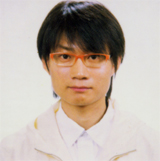 Ki-Won Lee Receives Best Student Paper Award
Ki-Won Lee Receives Best Student Paper Award
Ki-Won Lee, a doctoral student of Materials Science & Engineering, has received the Best Student Paper Award ‘Motorola Fellowship Award’ at 2007 Electronic Components and Technology Conference (ECTC).
Lee’s paper is about a new bonding process of anisotropic conductive film using ultrasonic wave, which applies ultrasonic wave, instead of thermal compression, at the room temperature to reduce the process time from ten to three seconds.
The recipients of Motorola Fellowship Award are selected by IEEE Components, Packaging and Manufacturing Technology Society, and Motorola awards special scholarship to recipients. The ECTC is the world’s largest yearly conference concerning electronic packaging technologies with more than 1,000 attendees and more than 300 presented papers.
2007.07.02 View 18743
Ki-Won Lee Receives Best Student Paper Award
Ki-Won Lee Receives Best Student Paper Award
Ki-Won Lee, a doctoral student of Materials Science & Engineering, has received the Best Student Paper Award ‘Motorola Fellowship Award’ at 2007 Electronic Components and Technology Conference (ECTC).
Lee’s paper is about a new bonding process of anisotropic conductive film using ultrasonic wave, which applies ultrasonic wave, instead of thermal compression, at the room temperature to reduce the process time from ten to three seconds.
The recipients of Motorola Fellowship Award are selected by IEEE Components, Packaging and Manufacturing Technology Society, and Motorola awards special scholarship to recipients. The ECTC is the world’s largest yearly conference concerning electronic packaging technologies with more than 1,000 attendees and more than 300 presented papers.
2007.07.02 View 18743 -
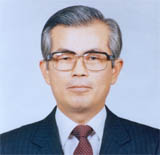 Emeritus Professor Lee Dies
Jeong-Oh Lee, Emeritus Professor of Mechanical Engineering, died of his chronic disease on June 15, 2007 at his age of 76.
The late Lee began his lecturing career at Mechanical Engineering Department in 1973 and had made considerable devotions to the education and development of mechanical engineering for 24 years. As the former Minister of Science and Technology, former President of Korea Institute of Science and Technology, and former President of Korea Advanced Institute of Science and Technology, he also has made significant contributions to the development of Korean science and technology.
Particularly, he played key roles in vitalizing Daeduk Research Complex (DRC) by planning and executing the movement of government-funded institutes despite the inactive research atmosphere in the early 1980s. He also set up the Extended Council for Technology Promotion, consisting of many distinguished persons from diverse fields under the supervision of the President, to make significant contributions to the promotion and spread of technology innovation among governmental and civil enterprises. He received Cheongjo Geunjeong Medal in 1985 and never stopped his devotion to the education of young students even after his retirement in 1997.
<Funeral Notice>- Date: Sunday, June 17, 2007 at 7 am.- Place: Eulji University Hospital, Daejeon- Graveyard: Cheonan graveyard- Bereaved family Wife Ok-Hyang Kang Son Jong-Sun Lee, Professor of Handong University Han-Sun Lee, LG Chemicals Daughter Myung-Ae Lee Son-in-law Young-Soo Lee, Korea Institute of Industrial Technology- Contact Point: C.P. 019.480.2451 (Han-Sun Lee)
2007.06.18 View 17144
Emeritus Professor Lee Dies
Jeong-Oh Lee, Emeritus Professor of Mechanical Engineering, died of his chronic disease on June 15, 2007 at his age of 76.
The late Lee began his lecturing career at Mechanical Engineering Department in 1973 and had made considerable devotions to the education and development of mechanical engineering for 24 years. As the former Minister of Science and Technology, former President of Korea Institute of Science and Technology, and former President of Korea Advanced Institute of Science and Technology, he also has made significant contributions to the development of Korean science and technology.
Particularly, he played key roles in vitalizing Daeduk Research Complex (DRC) by planning and executing the movement of government-funded institutes despite the inactive research atmosphere in the early 1980s. He also set up the Extended Council for Technology Promotion, consisting of many distinguished persons from diverse fields under the supervision of the President, to make significant contributions to the promotion and spread of technology innovation among governmental and civil enterprises. He received Cheongjo Geunjeong Medal in 1985 and never stopped his devotion to the education of young students even after his retirement in 1997.
<Funeral Notice>- Date: Sunday, June 17, 2007 at 7 am.- Place: Eulji University Hospital, Daejeon- Graveyard: Cheonan graveyard- Bereaved family Wife Ok-Hyang Kang Son Jong-Sun Lee, Professor of Handong University Han-Sun Lee, LG Chemicals Daughter Myung-Ae Lee Son-in-law Young-Soo Lee, Korea Institute of Industrial Technology- Contact Point: C.P. 019.480.2451 (Han-Sun Lee)
2007.06.18 View 17144 -
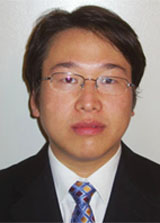 KAIST Graduate Selected As Winner of IEEE Outstanding Young Engineer Award
- First Korean winner of IEEE Outstanding Young Engineer Award
Dr. Myung-Jin Rhim, Bachelor, Master, and Ph.D of KAIST, has been selected to receive 2007 Outstanding Young Engineer Award by the Institute of Electrical and Electronics Engineers (IEEE) Components, Packaging, and Manufacturing Technology (CPMT) Society. Dr. Rhim will be the first Korean winner of the award.
Dr. Rhim received his Ph.D of Materials Science & Engineering at KAIST in 2001 and has made outstanding research outputs, such as 28 papers at international journals covered by Science Citation Index (SCI) and 12 international patents. He has been also listed in Marquis Who’s Who in the World, Who’s Who of Emerging Leaders, Who’s Who in Asia, and Outstanding Intellectual of the 21st Century, 21st Century Award for Achievement published by the International Biographical Centre of Cambridge, England.
IEEE CPMT Society has yearly awarded the Outstanding Young Engineer Award to a scientist or engineer of electronic components, packaging, and manufacturing technology prior to his or her 35th birthday in recognition of his or her research achievements. Dr. Rhim is now in his postdoctoral program at Georgia Institute of Technology in USA.
2007.06.14 View 17694
KAIST Graduate Selected As Winner of IEEE Outstanding Young Engineer Award
- First Korean winner of IEEE Outstanding Young Engineer Award
Dr. Myung-Jin Rhim, Bachelor, Master, and Ph.D of KAIST, has been selected to receive 2007 Outstanding Young Engineer Award by the Institute of Electrical and Electronics Engineers (IEEE) Components, Packaging, and Manufacturing Technology (CPMT) Society. Dr. Rhim will be the first Korean winner of the award.
Dr. Rhim received his Ph.D of Materials Science & Engineering at KAIST in 2001 and has made outstanding research outputs, such as 28 papers at international journals covered by Science Citation Index (SCI) and 12 international patents. He has been also listed in Marquis Who’s Who in the World, Who’s Who of Emerging Leaders, Who’s Who in Asia, and Outstanding Intellectual of the 21st Century, 21st Century Award for Achievement published by the International Biographical Centre of Cambridge, England.
IEEE CPMT Society has yearly awarded the Outstanding Young Engineer Award to a scientist or engineer of electronic components, packaging, and manufacturing technology prior to his or her 35th birthday in recognition of his or her research achievements. Dr. Rhim is now in his postdoctoral program at Georgia Institute of Technology in USA.
2007.06.14 View 17694 -
 Largest Number of Teams Selected From KAIST at 2007 LG Global Challenger Contest
Largest Number of Teams Selected From KAIST at 2007 LG Global Challenger Contest
The largest number of teams has been selected from KAIST at 2007 LG Global Challenger Contest
Despite of the record high competitive rate of 30/ 800, the largest number of teams has been selected from KAIST at 2007 LG Global Challenger Contest.
LG Global Challenger Contest is an exploration program where undergraduate and graduate students perform explorations on their own schedules and share the results with the public online.
Thus far, about 1,500 students from 410 teams have participated in the contest, and the contest is now regarded as the most representative overseas exploration program among university students, showing the average competitive rate of 1/ 20.
Exploration teams are selected by thorough examination and the members of selected teams have to complete the preliminary education program. The exploration teams will perform two-week overseas exploration on their own schedule during the summer vacation and their exploration activities will be relayed through the official web site of the contest by the designated team for online relay.
The exploration teams are obliged to submit the result reports, and the winners of the prize for good reports will be granted scholarship and employment privileges. The followings are the selected teams from KAIST:
Name: U-rekaTopic: U-Eco City, Advanced city where nature and human are well harmonizedMembers: A-Chim Chang (Department of Civil and Environmental Engineering)Hyuk-Il Cho (Department of Computer Sciences)Jung-Hyun Hong (Department of Industrial Engineering)Seung-Kyun Ryu (Department of Computer Sciences)
Name: TWIMTopic: The trend of unmanned ground vehicle development and its influence on unmanned societyMembers: Moon-Jung Byun (Department of Mechanical Engineering)Joon-Seok Park (Department of Electrical Engineering)Hye-Sun Hyun (Department of Electrical Engineering)Jong-Hoon Kim (Department of Electrical Engineering)
Team Impediment-free ODATopic: Future way of Korean ODAMembers: Joon-Youn Kim (Department of Industrial Engineering) Jae-Min Kim (Department of Industrial Engineering)Yoon-Jung Choi (Department of Industrial Engineering)Seul-Ki Lee (Department of Industrial Engineering)
2007.06.12 View 18480
Largest Number of Teams Selected From KAIST at 2007 LG Global Challenger Contest
Largest Number of Teams Selected From KAIST at 2007 LG Global Challenger Contest
The largest number of teams has been selected from KAIST at 2007 LG Global Challenger Contest
Despite of the record high competitive rate of 30/ 800, the largest number of teams has been selected from KAIST at 2007 LG Global Challenger Contest.
LG Global Challenger Contest is an exploration program where undergraduate and graduate students perform explorations on their own schedules and share the results with the public online.
Thus far, about 1,500 students from 410 teams have participated in the contest, and the contest is now regarded as the most representative overseas exploration program among university students, showing the average competitive rate of 1/ 20.
Exploration teams are selected by thorough examination and the members of selected teams have to complete the preliminary education program. The exploration teams will perform two-week overseas exploration on their own schedule during the summer vacation and their exploration activities will be relayed through the official web site of the contest by the designated team for online relay.
The exploration teams are obliged to submit the result reports, and the winners of the prize for good reports will be granted scholarship and employment privileges. The followings are the selected teams from KAIST:
Name: U-rekaTopic: U-Eco City, Advanced city where nature and human are well harmonizedMembers: A-Chim Chang (Department of Civil and Environmental Engineering)Hyuk-Il Cho (Department of Computer Sciences)Jung-Hyun Hong (Department of Industrial Engineering)Seung-Kyun Ryu (Department of Computer Sciences)
Name: TWIMTopic: The trend of unmanned ground vehicle development and its influence on unmanned societyMembers: Moon-Jung Byun (Department of Mechanical Engineering)Joon-Seok Park (Department of Electrical Engineering)Hye-Sun Hyun (Department of Electrical Engineering)Jong-Hoon Kim (Department of Electrical Engineering)
Team Impediment-free ODATopic: Future way of Korean ODAMembers: Joon-Youn Kim (Department of Industrial Engineering) Jae-Min Kim (Department of Industrial Engineering)Yoon-Jung Choi (Department of Industrial Engineering)Seul-Ki Lee (Department of Industrial Engineering)
2007.06.12 View 18480 -
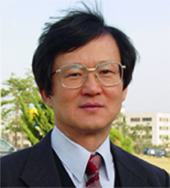 Prof. Lee Plants Commemorative Flower at NUAA
Prof. Lee Plants Commemorative Flower at NUAA
Professor In Lee of Aerospace Engineering planted a commemorative flower - Hibiscus, the national flora of South Korea - at Nanjing University of Aeronautics and Astronautics (NUAA) on May 25, 2007. While some Chinese Nobel laureates have planted commemorative trees, Professor Lee is the first foreigner who has planted a commemorative flower at NUAA. His planting is expected to contribute to opening academic and research exchanges between South Korea and China.
NUAA is the top university of China in the field of Aerospace Engineering and a technical university consisting of 2,800 faculty and staff and 26,000 students.
NUAA has colleges of Aerospace Engineering, Science, Engineering, Management, Art, Humanity, Foreign Language, and International Education and actively promotes international academic and research exchanges and international student program.
2007.06.12 View 13409
Prof. Lee Plants Commemorative Flower at NUAA
Prof. Lee Plants Commemorative Flower at NUAA
Professor In Lee of Aerospace Engineering planted a commemorative flower - Hibiscus, the national flora of South Korea - at Nanjing University of Aeronautics and Astronautics (NUAA) on May 25, 2007. While some Chinese Nobel laureates have planted commemorative trees, Professor Lee is the first foreigner who has planted a commemorative flower at NUAA. His planting is expected to contribute to opening academic and research exchanges between South Korea and China.
NUAA is the top university of China in the field of Aerospace Engineering and a technical university consisting of 2,800 faculty and staff and 26,000 students.
NUAA has colleges of Aerospace Engineering, Science, Engineering, Management, Art, Humanity, Foreign Language, and International Education and actively promotes international academic and research exchanges and international student program.
2007.06.12 View 13409 -
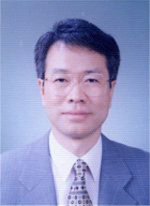 Prof. Whang Named Distinguished Database Profile by ACM SIGMOD
Professor Kyu-Young Whang of Computer Sciences has been named as Distinguished Database Profile (DDP) by Association for Computing Machinery Special Interest Group on Management Of Data (ACM SIGMOD).
DDP is a section of ACM SIGMOD Record that introduces researchers who have made significant global contributions in database field.
Thus far, about 20 researchers including Jeff Ullman and Jim Gray have been named as DDPs for their achievements such as establishment of new theories and technologies in database field, and Prof. Hwang is the first researcher named as DDP in the Asian-Pacific region.
Prof. Whang’s interview (directed by Marianne Winslett, Professor of UIUC, and Eric Bina, co-founder of Netscape) can be seen on http://www.sigmod.org/interviews and will be published at ACM SIGMOD Record in 2008.
2007.06.07 View 14839
Prof. Whang Named Distinguished Database Profile by ACM SIGMOD
Professor Kyu-Young Whang of Computer Sciences has been named as Distinguished Database Profile (DDP) by Association for Computing Machinery Special Interest Group on Management Of Data (ACM SIGMOD).
DDP is a section of ACM SIGMOD Record that introduces researchers who have made significant global contributions in database field.
Thus far, about 20 researchers including Jeff Ullman and Jim Gray have been named as DDPs for their achievements such as establishment of new theories and technologies in database field, and Prof. Hwang is the first researcher named as DDP in the Asian-Pacific region.
Prof. Whang’s interview (directed by Marianne Winslett, Professor of UIUC, and Eric Bina, co-founder of Netscape) can be seen on http://www.sigmod.org/interviews and will be published at ACM SIGMOD Record in 2008.
2007.06.07 View 14839